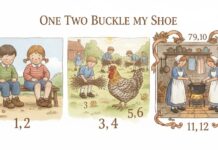Jack Be Nimble Nursery Rhymes
🕰 Origins
- First Recorded – The rhyme was first documented around 1815 and later collected by folklorist James Orchard Halliwell in the mid‑19th century.
- Cultural Practice – It’s rooted in the old English tradition of jumping over candlesticks. In the 18th–19th centuries, this was both a sport and a form of fortune‑telling. If you cleared the flame without extinguishing it, it meant good luck; if the flame went out, it was a bad omen.
- Name “Jack” – A common placeholder name in English rhymes and proverbs, used to represent the “everyman.”
📜 Meaning
- Literal Reading – A short verse encouraging agility: Jack must be nimble and quick to jump over the candlestick.
- Symbolic Layer – The rhyme reflects the importance of being spry, adaptable, and lucky—qualities valued in everyday life.
- Instructional Tone – The imperative “Jack, be nimble!” can be read as advice or encouragement, giving the rhyme a motivational edge.
🌟 Fun Facts
- Fortune‑Telling Ritual – Jumping candlesticks was often performed at weddings and fairs as a way to predict prosperity.
- Illustrations – William Wallace Denslow’s 1901 Mother Goose edition famously depicted Jack as a dog leaping over the candle.
- Pop Culture – Referenced in Don McLean’s American Pie (“Jack be nimble, Jack be quick, Jack Flash sat on a candlestick”), and even parodied in Sesame Street with Kermit the Frog calling it “weird”.
- Roud Folk Song Index – Catalogued as number 13902, marking it as part of the official English folk song heritage.

Jack be nimble,
Jack be quick,
Jack jump over
The candlestick.




















